Cured Salami
Showing all 8 results
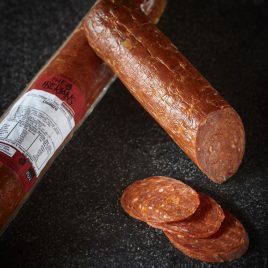
Chorizo of Pamplona
The chorizo of Pamplona (chorizo pamplonica) is the most popular and widely known of all of the pork sausages. Typically, in Pamplona and in other Navarre Pyrenees villages chorizo is stuffed into natural sausage casing 60-55mm wide and traditionally presented in the form of a horseshoe shape or in enchiladas, 10cm sections tied with natural cotton.
In southern Navarra the chorizo is smaller in diameter similar to the typical sausage, and in the central region and in the north, you will find them candle shaped which is unique to this region and called Cular (the lower part of the intestine considered a delicacy). With the fantastic climatic conditions of the north east of Navarra there are some truly delicious sausages to be had of which jaurrieta is the most prominent.
The most famous of the chorizo without a doubt is chorizo Pamplona with its specific characteristics of finely chopped pork, it is widely appreciated across Spain. The recipe is no secret – finely chop 80% of first quality pork with 20% pork fat, marinate with a dash of salt and smoked paprika add a head of chopped garlic all bought together with a little spring water. The mondongueras is left to macerate overnight and then stuffed into either artificial or natural candle shaped casings 65mm in diameter. Chorizo de Pamplona is the quintessential reflection of the Spanish nature - full bodied, spicy with delicate portions and generous flavours.
The weather of Pamplona is also another essential factor in the drying process as it takes a minimum of three months to become perfectly cured, giving the chorizo one of its most favored flavour characteristics. The chorizo is then wrapped in paper to prevent the sausage from oxidising and changing to yellowish tones, though it does not spoil its quality it will be rejected by the commercial market.
The tradition has origins from a time when people slaughtered their own meat at home and cured the sausage in their cellars. The making of this chorizo begins in winter when families traditionally slaughter the pigs and then communally make the chorizo, curing it in the cellar until the fiesta of San Fermín. Then the festival of Pamplona begins when the Chupinazo is launched (miniature rocket) and the running of the bulls commences.
In Spain this cured sausage is typically served in thin slices and has an important role in the festivals of Pamplona with the most famous “the running of the bulls”.
Download our info sheet
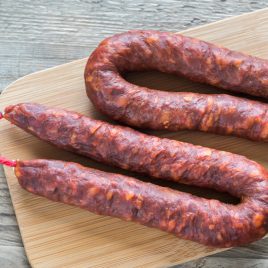
Air dried Hot / Mild Chorizo
In 15th Century Spain livestock was raised outside the cities and the animals killed in abbatoirs, the meat then sold to the butchers. But with the pigs it was different, the pig was still being raised in the villages, it was killed in the streets and the sausage was made by the family. This custom is something that still persists in some towns of Spain, el matadero (the slaughter of the pig).
It is likely that chorizo was the first cured product that due to its age and extension gained the attention of the Spanish Royal Academy of Language whom defined in the Dictionary of Authorities in 1726 as "short piece of tripe, full of meat, regularly of pork, minced and marinated, which is normally cured by smoke ". In such time the paprika was not yet common spice to the Spanish pork-butchery.
The Spanish chorizo is red due to the paprika with the ingredient arriving in Spain in the 16th Century, from the Americas. Before the paprika arrived on the Iberian Peninsula sausages were whitish or black if they were made with blood and sausage recipes can be found in ‘women’s manuals’ dating back to the 16th Century.
The chorizo picante (spicy chorizo) is made with lean and fat pork, smoked and cured, traditionally made in the winter months taking advantage of the cold and frost these conditions giving it the characteristic dark red colour and aroma. There are three types of chorizo sartar, cular and vela.
Tasting themes: sliced thin for sandwiches or tapas, fried with olive oil, cooked in stews with grains (lentils, chickpeas, white beans) plus a host of gastronomic combinations very typical of Castillian lands.
Download our info sheet

Fuet longaniza
Fuets, secallones, and somalles are dry sausages or the family of matured or "cured", typical of Catalonia, relatives of raw butifarra and sausage (fresh or dried). Its origin has to go looking for it in the Roman era, since they derive from the Lucania (from where comes the word "longaniza") that, in all likelihood, as today, was already elaborated in the Pyrenees, where the Romans (concretely of the Cerdanya) already affirmed that the best hams were made.
The Fuet de campo is a classic in the canon of the salumiere’s art. The old legend says that a light-fingered Catalan stole some regular fuet and was discovered to escape he left the sausage hidden in a patch of wild fennel. Later when he came back for it, the fuet smelled beautifully with that sweet, herby, anise aroma.
The subtle aniseed taste from the fennel is a match made in heaven that you can detect when consuming but the cured pork like all dried sausage is the true star of the show.
The traditional fuet is made from wild fennel seeds and organic Catalan vino blanco (white wine) and imparts a bolder flavour. Fennel pollen is another optional ingredient in this fuet, it has a very floral bouquet but doesn’t keep for a long time, after about six months or so, it will lose its aroma.
Most Mediterranean cultures have an anise-flavoured liqueur and this is generally added Finally, to enhance the flavour of the cured meat.
The herbs and wild fennel extend their flavours and combine perfectly with the lean pork during the curing process to produce a stunning version of this Catalan classic.
A tasting theme: tapas, charcutarie board or with a crusty baguette and for the Catalan it is an essential afternoon snack.
Download our info sheet
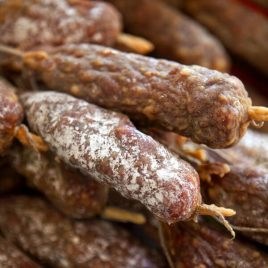
Fuet Secallona (Osona)
Fuets, secallones and somalles are from the family of matured or “cured" dry sausages, typical of Catalonia and relatives of the raw butifarra fresh or dry sausage. Lucania (where the word longaniza originates), has its roots in the Pyrenees.The origin of these sausages dates back to Roman times and is from the lucanica people (southern Italian). By all accounts the fuets, secallones and somalles were first made in the Pyrenees and due to the climatic conditions of the region they say this is where the best ‘hams’ originate.
The composition of these sausages is always pork and bacon seasoned with salt, and black pepper. The air and the microclimate of each region along with the time of maturation, do the rest. With names that sound exotic and mysterious such as Secallona, Somalla, Petador, Espetec, the truth is that they all are dried sausages that the Catalonian people refer to as fuet or longaniza. The manufacturing process is traditional, what separates them is the size. Longaniza and Secallona have a handmade quality with their appearance and fuet in contrast is shorter in size.
These different types of cured sausages are more or less regional in nature and they all follow an interesting point, in that they have an onomatopean characteristic which is the particular sound that fuet, espetec, llonganisseta, make when broken.
Within this family the secallona, somalla and petador are contemporary raw sausage products produced in two ways — long, called salsitxeta and small bite like portions cigala de gos, making them an ideal snack or finger food.
The Catalan term secallona refers to the appearance of dried fruit and this is where this pork sausage made from lean meat and pork fat stuffed into thin a natural sausage casing gets its name from. This cured dried sausage is infused with three different formats of black peppercorns powdered, cracked and whole.
A tasting theme: Secallona best sliced thick and served at room temperature and can be used in antipasto, tasting boards or in a crusty baguette drizzled with high quality Spanish olive oil.
Download our info sheet
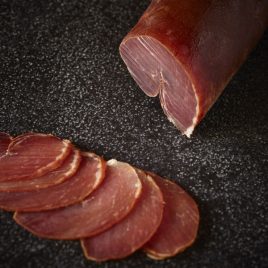
Lomo (Cured pork loin)
The lomo embuchado (pork loin) has its origin in Aragon (Spain), and is one of the cured meat products that have been protected under the Diputación de Aragón guarantee mark since 1993 in order to protect the quality of the product.
The preparation of the loin has been carried out in Aragon since ancient times. Originally the pork meat was obtained from the la matanza tradicional (traditional killings), now with the protection of the Diputación de Aragón guarantee mark ensures that the finest quality pork lion continues to be used as before.
The lomo embuchado of Aragon uses only the freshest meat free of the outer fat from castrated male pigs or females outside the estrus period, with salt and other natural spices marinated and then put into a sausage net. It is then allowed to mature for a maximum period of 60 days. The loin obtains an intense flavour, fine texture and is soft on the palate and is marketed with the seal of food quality. It comes in a ‘candle’ between 50 to 70 cm in length.
For their preparation, the loins are put to cure in salt and sugar for one or two days, then washed and left to air dry for a further two days until they are well drained. After the loin is marinated with a dressing prepared with paprika, garlic, oregano, and olive oil, they are put into elongated casings and hung for healing in a cool, dry environment for at least two to three months.
Its flavour is intense and natural, usually presented as a ‘candle’ or in thin slices cut vertically and vacuum packed, it then needs to be kept in a cool dry place. Its exterior colour is light and inside it has a dark vivid red colour with marble-like appearance, because of the fat that has infiltrated. The loin is consumed raw as it is a cured meat.
Tasting themes: Sliced thin in a crunchy baguette drizzled with a high-quality Spanish olive oil, in pinchos, on a charcuterie board.
Download our info sheet
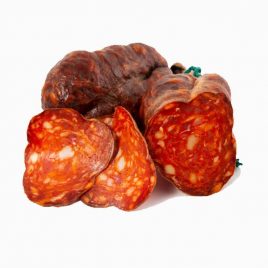
Morcón
Morcón is a type of chorizo, eaten in much the same way. The difference is the meat with which it is made, which is usually lean without much fat content, and that the meat is stuffed into a section of pork large intestine.
The marinade used to flavor the chorizo is mainly composed of paprika, garlic, and salt. Due to the thickness of the sausage, the maturity period is quite long.
It is typical of some regions in Spain such as Andalucía, Salamanca, and Extremadura.
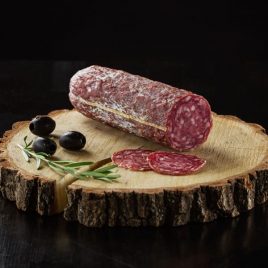
Salchichón (Hot, Mild, Truffle)
The salchichón popularly known as the wider longaniza is similar to the Spanish salami and has its origins in Greek and Roman times. These days it has gained a reputation as an appetizer, cut with a knife, accompanied by a quality tostada (toasted bread) and a good Spanish wine - this is very typical of the provenance of Barcelona, the capital of this particular sausage.
Salchichon de Vic is popular throughout the country and with its history, tradition and quality is easily recognised as a product of the lands of Osona region.
If we go a little deeper into history, we discover that Salchichon de Vic was mentioned for the first time in a 14th Century document found in the Episcopal Archives of Vic. Its fame spread throughout the late 19th Century when his Majesty Alfonso XII, King of Spain, when visiting the city of Vic made three visits - one to visit the Bishop, the other to go to the Cathedral and the third, to visit the sausage factory.
In order to achieve the characteristic flavour, the formula for its production has been maintained, imitating the work of the farmers of the Plana de Vic. They have since ancient times picked the best lean meat and fat from the pig marinating with garlic, salt and black pepper then hung in the cellar to cure. The pig breeds most used for their production of Salchichon de Vic are Berkshire, Large white and Duroc.
The Iberians have not wanted to lose the unmistakable flavor of traditional Spanish sausages and, over the years, have remained true to the classic recipes and processes. Through their careful attention to detail, artisanal process and dedication to the craft The Iberians produce one of the most authentic range of cured Spanish sausage in Australia.
A tasting theme: This product can easily replace any dish that contains Italian salami and in Catalonia it is used in salads, baguettes, tostadas with rubbed ripped tomato and on popular charcuterie board.
Download our info sheet

Sobrasada
Sobrasada is a traditional soft cured sausage from Mallorca made with ground pork, paprika, salt and spices, and it is the national sausage of the Balearic Islands. At The Iberians we start with premium quality free-range pork add a pinch of sea salt and sun dried paprika from De la Vera (DOP), the result is a finely textured Sobrasada of excellent quality.
It is traditionally shaped as a Salchichón, and wider than a chorizo. It is unique for its soft-spreadable texture.
A remarkable dish from the Balearic Islands is the Sobrasada omelette with ‘rubbed’ tomato on toast.
Sobrasada is usually served spread on crusty bread with Mahon cheese and toasted until it melts, there is no other sausage from Mallorca more typical than this except for the butifarró.
Sobrasada is a versatile sausage and can also be used as a filling in pasta dishes, on pizza or fried with sea food or meat and even as part of a honey-based sauce making it one of the most versatile products of all Spanish cured meats. This is a gluten free product.
Download our info sheet

